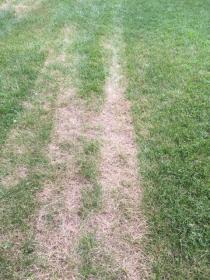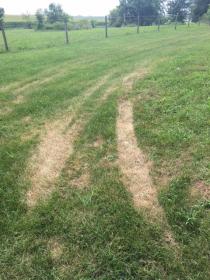[ATTACH=JSON]{“alt”:“Click image for larger version Name: IMG_3739.JPG Views: 1 Size: 16.1 KB ID: 10178800”,“data-align”:“none”,“data-attachmentid”:“10178800”,“data-size”:“medium”}[/ATTACH][ATTACH=JSON]{“alt”:“Click image for larger version Name: IMG_3740.JPG Views: 1 Size: 14.2 KB ID: 10178801”,“data-align”:“none”,“data-attachmentid”:“10178801”,“data-size”:“medium”}[/ATTACH]
Earleir this spring, we noticed a set of tire tracks where the grass had gone yellow, across our lawn and heading up to the hayfied. Spotty ‘covreage’ - there were places it was obvious, and other places you couldn’t really see any tracks. We have a beekeeper to whom we free-lease space on the property (and access to our clover!) for their bees, and in return we get delicious honey. The beekeeper is the only vehicle driving up that hill other than our ATV, and these were definitely standard on-road vehicle tires–not ATV tread width. I figured, well crap, he must have driven through a treated field before coming to my place. But it’s an isolated incident and the damage wasn’t extensive, and they’re really great guys to work with. So I didn’t raise a fuss. Well, it’s happened again-- there’s a new set of burned-out tire tracks (again going up to the field where the hives are. And I know the beekeepers were here within the last week because I can see their tire tracks in the hayfield going straight to the hives). And no one else has (legaL) access to the property, but of course we’re at work all day so who knows.
I reached out to the beekeepers today to alert them to the problem and sent the above pictures. His response: “I never rule anything completely out but I don’t know how it could be us. We would have to have wet herbicide on the tires. We do not use herbicides. We would have to contact it prior to entering your place. Just running down the road should wear it off anyway if we did contact it. We will be on the lookout though.”
I totally believe him when he says they don’t use herbicide–they’re an organic facility and super ‘green’. But is he right that even if there were incidental contact from another client’s field, the chemical would not persist on the tires? They’d be driving many miles to get to us, it’s not like they have clients on our road.
I wonder if we’re just seeing the impact of soil compaction? But seems inplausible to me that compaction would cause such a crisp line between dead/living grass. Or would it?
Or maybe we have someone trespassing, but you still have the fact that they’d be traveling miles over the road to get to us, and is Round-up really going to hang around on a tire for that long? And besides-- trespassing for what reason? It would be more understandable in morel or deer hunting season, but you’d need a blood transfusion after dealing with the thorns in our woods in summer. It gets almost impenetrable.
I’m stumped. Sure seems like Round-up on tires, but I believe my beekeeper when he says he doesn’t think it’s them.
Any ideas?


